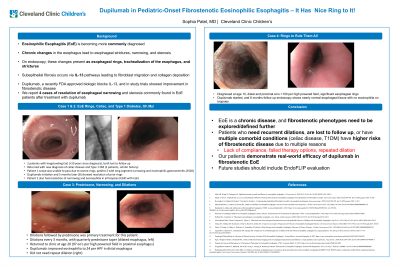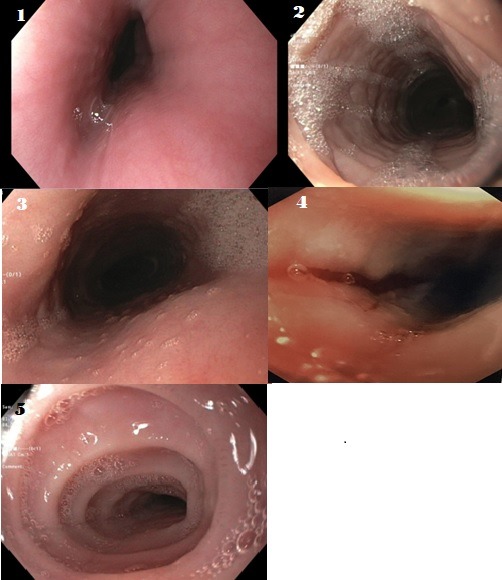Sunday Poster Session
Category: Pediatrics
P1187 - Dupilumab in Fibrostenotic Pediatric-Onset Eosinophilic Esophagitis - It Has a Nice Ring to It
Sunday, October 22, 2023
3:30 PM - 7:00 PM PT
Location: Exhibit Hall

Has Audio
.jpg)
Sophia A. Patel, MD
Cleveland Clinic Children's
Cleveland, OH
Presenting Author(s)
Award: Presidential Poster Award
Sophia A. Patel, MD
Cleveland Clinic Children's, Cleveland, OH
Introduction: Eosinophilic esophagitis (EoE) is an increasingly prevalent immune-mediated disease that leads to chronic changes including strictures, narrowing, and stenosis in the esophagus. IL-13 plays a role in fibrosis through increasing migration of fibroblasts and subepithelial fibrosis. Dupilumab, a biologic therapy aimed at blocking IL-13, has been shown to improve fibrosis in clinical trials. We report here 4 unique pediatric patients with fibrostenotic EoE who had resolution of their strictures with dupilumab therapy.
Case Description/Methods: The first patient was 8 years old at diagnosis. He required dilation on every 3 month basis from age 14-19 (Fig 1). Biopsies showed eosinophilia of 97/HPF in the proximal esophagus. Dupilumab therapy was initiated at age 20, and repeat endoscopy revealed no need for dilation along with improvement in histologic findings.
The next patient was diagnosed with EoE as a 5-year-old. At age 17, with celiac disease and diabetes mellitus type 1 (T1DM) diagnoses, he returned with significant dysphagia. His esophageal mucosa is seen in Fig 1, with trachealization and severe rings. Histology showed distal esophageal eosinophilia of 40/HPF. With 300mg weekly of dupilumab, repeat endoscopy after 4 months in Fig 2 shows resolution of prior findings of ring formation.
The third patient was diagnosed at age 10, with >100 eosinophils/HPF in esophageal biopsies with gastric eosinophilia. Endoscopy revealed narrowing with superficial mucosal tear (Fig 3) following pediatric endoscope passage. He also had history of celiac disease and T1DM. He was started on dupilumab, and following 3 months of, the patient had resolution of narrowing and no eosinophilia in all biopsies.
The fourth patient was also diagnosed with EoE at age 10. He re-presented at age 17 with recurrent dysphagia. Endoscopy demonstrated severe esophageal rings and narrowing (Fig 4). Biopsies showed >100 eosinophils per HPF. The patient was started on dupilumab following this endoscopy, and 4 months later, on repeat endoscopy he had resolution of rings (Fig 5).
Discussion: In this case series, we present 4 unique pediatric patients with fibrostenotic EoE who had resolution of narrowing using dupilumab. It demonstrates real-world evidence of dupilumab’s fibrosis remodeling effect which is the largest series reported in a pediatric-onset group. We show that dupilumab is safe in fibrostenotic EoE, and should be strongly considered in these populations as an alternative to repetitive dilations.

Disclosures:
Sophia A. Patel, MD. P1187 - Dupilumab in Fibrostenotic Pediatric-Onset Eosinophilic Esophagitis - It Has a Nice Ring to It, ACG 2023 Annual Scientific Meeting Abstracts. Vancouver, BC, Canada: American College of Gastroenterology.
Sophia A. Patel, MD
Cleveland Clinic Children's, Cleveland, OH
Introduction: Eosinophilic esophagitis (EoE) is an increasingly prevalent immune-mediated disease that leads to chronic changes including strictures, narrowing, and stenosis in the esophagus. IL-13 plays a role in fibrosis through increasing migration of fibroblasts and subepithelial fibrosis. Dupilumab, a biologic therapy aimed at blocking IL-13, has been shown to improve fibrosis in clinical trials. We report here 4 unique pediatric patients with fibrostenotic EoE who had resolution of their strictures with dupilumab therapy.
Case Description/Methods: The first patient was 8 years old at diagnosis. He required dilation on every 3 month basis from age 14-19 (Fig 1). Biopsies showed eosinophilia of 97/HPF in the proximal esophagus. Dupilumab therapy was initiated at age 20, and repeat endoscopy revealed no need for dilation along with improvement in histologic findings.
The next patient was diagnosed with EoE as a 5-year-old. At age 17, with celiac disease and diabetes mellitus type 1 (T1DM) diagnoses, he returned with significant dysphagia. His esophageal mucosa is seen in Fig 1, with trachealization and severe rings. Histology showed distal esophageal eosinophilia of 40/HPF. With 300mg weekly of dupilumab, repeat endoscopy after 4 months in Fig 2 shows resolution of prior findings of ring formation.
The third patient was diagnosed at age 10, with >100 eosinophils/HPF in esophageal biopsies with gastric eosinophilia. Endoscopy revealed narrowing with superficial mucosal tear (Fig 3) following pediatric endoscope passage. He also had history of celiac disease and T1DM. He was started on dupilumab, and following 3 months of, the patient had resolution of narrowing and no eosinophilia in all biopsies.
The fourth patient was also diagnosed with EoE at age 10. He re-presented at age 17 with recurrent dysphagia. Endoscopy demonstrated severe esophageal rings and narrowing (Fig 4). Biopsies showed >100 eosinophils per HPF. The patient was started on dupilumab following this endoscopy, and 4 months later, on repeat endoscopy he had resolution of rings (Fig 5).
Discussion: In this case series, we present 4 unique pediatric patients with fibrostenotic EoE who had resolution of narrowing using dupilumab. It demonstrates real-world evidence of dupilumab’s fibrosis remodeling effect which is the largest series reported in a pediatric-onset group. We show that dupilumab is safe in fibrostenotic EoE, and should be strongly considered in these populations as an alternative to repetitive dilations.

Figure: Figures as noted in abstract (1,2,3,4,5)
Disclosures:
Sophia Patel: Regeneron - Sanofi – Advisor or Review Panel Member, Advisory Committee/Board Member.
Sophia A. Patel, MD. P1187 - Dupilumab in Fibrostenotic Pediatric-Onset Eosinophilic Esophagitis - It Has a Nice Ring to It, ACG 2023 Annual Scientific Meeting Abstracts. Vancouver, BC, Canada: American College of Gastroenterology.

